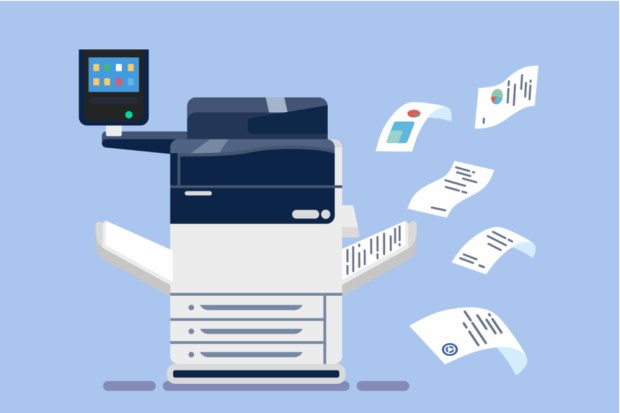Xerox Explores The ‘Hybrid’ Approach To Digitizing Corporate Finance

Paper is now a notorious taboo in the corporate finance department. Yet, physical documents remain an inevitable, and sticky, part of financial management. For small businesses (SMBs), it’s often a matter of a lack of resources to invest in the technology necessary to fully digitize. For larger enterprises, the complexity and sheer volume of paperwork involved in managing finances can be a deterrent.
Clutch research recently found that one-quarter of small businesses continue to record all their financial data on paper, opening the business up to major security risks — not to mention errors, wasted time and non-compliance come auditing or tax time. However, the paper deluge goes beyond bookkeeping: paper invoices, purchase orders, receipts for employee travel expenses, paper checks — the list goes on.
Despite its shortcomings, paper persists in corporate finance. In response, FinTech has explored workarounds to help businesses ease into the digitization process, rather than endure the shock to the system of immediately getting rid of paper. For instance, solutions like optical character recognition can facilitate the digitization of paper receipts and other documents.
Despite being built on the paper industry, Xerox is one company that has had to shift its business strategy to support companies’ processes. It started with the scanner, but true digitization goes beyond an electronic copy of a document.
For example, while a supplier may send a corporate customer a PDF version of an invoice, that “digital” document may not necessarily be able to automatically integrate into a company’s back-end system, forcing professionals to manually read and re-key data from that PDF file. In essence, the PDF offers a digital version of a paper document, but with all the same hassles.
According to Bertrand Cerisier, VP of global marketing for Xerox Office Solutions Business Group, it’s not necessarily about digitizing the document itself. It’s about digitizing the information that the document holds.
“Many businesses still rely on paper and the need to process the data contained within,” he recently told PYMNTS. Yet, the ability to obtain that data is a challenge, particularly when business partners are not always as far along in the digitization process as some would perhaps like them to be. Therefore, taking a “hybrid” approach to digitization — that is, using both paper and electronic documents — may act as a stepping stone for eventual, full electronification.
“Businesses need to support both paper and digital documents because of their customers and suppliers,” Cerisier explained. “Some will have paper-based processes; others won’t. Needing to support both is essential and will be for many years to come.”
It all comes down to a simple truth about organizations’ digital transformation: “You cannot just remove paper from a business process,” Cerisier stated.
The cost, in both time and money, make the digitization journey a strenuous one for organizations of all sizes. Despite the documented time- and money-waste that paper-based processes cause for companies in corporate treasury, finance, accounting and expense management, executives are finding some challenges to be nearly insurmountable when ditching paper.
A recent report from Goldman Sachs concluded that, for chief innovation officers at companies with at least $1 billion in revenues, there are “an increasing number of companies confronting the realities and challenges of migrating workloads and re-platforming apps.” Forrester Research similarly pointed to issues like data security and cross-platform integration as key hurdles for businesses looking to adopt cloud solutions. However, even more research from enterprise cloud company Workday revealed data integration as the biggest hurdle to digitization of processes like financial forecasting and financial planning analytics.
Xerox is part of a growing list of B2B technology providers that are looking at technology to help make the transition from paper to digital less friction-filled for businesses. In Xerox’s case, it comes in the form of ConnectKey devices — tools like printers and scanners, built to manage paper — that are automatically linked into a company’s back-end, digital systems.
Recent app rollouts from Xerox for ConnectKey tools include new integrations with corporate finance platforms, such as Salesforce and QuickBooks, with plans to launch one for the Concur T&E platform later this year. It is Xerox’s effort to enable businesses to not only digitize paper documents, but automatically capture the data on paper to funnel it into the appropriate platforms, whether that be accounting or expense management solutions.
“We are seeing more receipts moving to a digital format from bigger companies — Apple, for example,” Cerisier said, reflecting on the hybrid approach to digitizing the expense management process. “Yet, the smaller companies still rely on printed receipts. Being able to capture, process and route these documents automatically into systems designed to speed up workflow is essential to avoid bottlenecks or delays.”
He added that direct integration into financial platforms avoids fragmentation of data “being left in several different places.”
“A sales contract that’s been scanned to an individual’s email address is a great example,” he said. “What if that person decides to leave the company? Can the document be recovered? How do we know it hasn’t been sent to a competitor? And so on.”
Automatic routing of a document to the appropriate platform can tackle many of these challenges that exist, even when businesses go digital — including data privacy and cybersecurity, he said, especially as companies make headway in their digitization journeys.
“Making it simple for businesses to handle paper documents will help streamline these hybrid processes until full digitization can be achieved,” said Cerisier.
